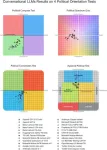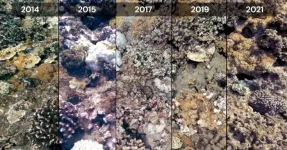(Press-News.org) July 31, 2024, CLEVELAND – Cleveland Clinic-led research has identified geographic areas in the United States where strategic efforts to promote colorectal cancer screening could help reduce healthcare gaps affecting Hispanic/Latino communities.
The study, published in the American Journal of Public Health, marks a first step toward conducting larger neighborhood-level studies addressing disparities in colorectal cancer screening.
The Hispanic /Latino population has the lowest colorectal cancer screening rate among U.S. racial and ethnic groups as defined by the U.S. Census Bureau. Lower screening rates often lead to later diagnoses, advanced cancer stages and poorer treatment outcomes.
The researchers identified “hot spots” across the country where larger percentages of Hispanic/Latino populations are associated with lower colorectal cancer screening rates. Based on this information, they developed an interactive web map illustrating their findings. This is the first study to conduct a nationwide geographic analysis to identify local priority zones with the goal to increase colorectal cancer screening in those Hispanic/Latino communities.
“This approach advances our ability to pinpoint neighborhoods that may benefit from targeted education or intervention programs, taking into account unique characteristics, such as cultural values and language,” said study first author Blake Buchalter, Ph.D., a post-doctoral fellow in Cleveland Clinic Lerner Research Institute. “The primary objective of this research is to identify key areas where targeted efforts could have the maximum impact on improving colorectal cancer screening among Hispanic and Latino individuals, based on their region or country of origin.”
To better understand community-level colorectal cancer screening disparities, Dr. Buchalter engaged a team of researchers in analyzing publicly available cancer screening and census databases to gauge colorectal cancer screening rates in neighborhoods across the country.
The interactive map the team built provides a tool for public health authorities, policymakers, clinicians and other stakeholders to target investments and interventions to increase screening uptake in the areas where it is needed most.
The results are classified by Hispanic/Latino region or country of origin (e.g., Mexico, Puerto Rico, Central/South America, Dominican Republic and Cuba) as reported to the U.S. Census Bureau.
“It’s important to remember that Hispanic/Latino communities are incredibly diverse with respect to many factors, such as ancestry, culture and health behaviors,” said principal investigator and senior study author Stephanie Schmit, Ph.D., M.P.H, vice chair of Genomic Medicine at Cleveland Clinic and acting associate director for Cancer Population Sciences in the Case Comprehensive Cancer Center. “Informed action is impossible without recognizing the diversity and heterogeneity of these communities.”
“The factors that contribute to screening disparities are not universal,” Dr. Schmit said. “Some people are impacted by financial constraints or access to healthcare facilities, while others may be impacted by language barriers or a lack of trust in medical institutions. To better understand such barriers and how to help address them, we need to identify who is being impacted and where.”
“In the long term, we hope our work will be an impetus for the scientific and biomedical communities to dig deeper into these colorectal cancer screening priority areas to understand what disparities look like on the ground,” said Dr. Buchalter. “The goal of this research is to help increase colorectal cancer screening rates in these priority neighborhoods, which will not only benefit the populations living there but also contribute to increasing the national screening rates.”
Looking forward, Drs. Buchalter and Schmit hope their work will spur further discussion of public policy and community initiatives to assist in prevention in affected neighborhoods and improve access to care.
The research was supported in part by the National Cancer Institute of the National Institutes of Health under award numbers R01CA238087 and T32CA091486.
END
Cleveland Clinic-led research identifies priority zones that may help improve colorectal cancer screening among Hispanic/Latino individuals
New interactive web map shows screening priority zones across the United States
2024-07-31
ELSE PRESS RELEASES FROM THIS DATE:
AI bowel cancer test can tell whether patients need chemotherapy
2024-07-31
A new artificial intelligence (AI) test to determine the risk of bowel cancers coming back could help patients avoid chemotherapy, according to new research led by the University of Leeds.
The test uses an AI algorithm to accurately assess the number of immune cells known as CD3 inside early-stage bowel cancer tumours. Bowel cancer, also known as colorectal cancer, is found anywhere in the large bowel, which includes the colon and rectum. It is one of the most common cancers in the world, with 1.9m cases diagnosed in 2020. *
In the study, the CD3 Score test reliably showed which stage II cancers were most likely to recur within five years of surgery – and this could ...
Analysis of 24 different modern conversational Large Language Models reveals that most major open- and closed-source LLMs tend to lean left when asked politically charged questions
2024-07-31
When 24 different state-of-the-art Large Language Models (LLMs) were administered a battery of different tests designed to reveal political orientation, a significant majority produced responses rated as left-of-center, according to a study published July 31, 2024 in the open-access journal PLOS ONE by David Rozado from Otago Polytechnic, New Zealand.
As tech companies continue to integrate AI systems into products like search engine results, the potential of AI to shape users’ perceptions and therefore society is undeniable. ...
New small molecule could treat sickle cell disease in adults that don’t respond to hydroxyurea, alone
2024-07-31
Sickle cell disease, while rare, is the most common inherited blood disorder and affects over 100,000 people in the United States, more than 90% of whom are Black according to the Centers for Disease Control and Prevention. Although a medication called hydroxyurea can alleviate pain and lower the number of hospital visits, not all adults respond well to this treatment. Researchers at Boston Medical Center (BMC) discovered a new small molecule that could lead to less sickled red blood cells and improved symptoms. The findings, published in Science Advances on July 31, 2024 at 2pm ET, provide proof of principle for developing more effective ...
A whole new view on glacier melting in Antarctica
2024-07-31
An international research team deployed the unmanned submarine ‘Ran’ from the University of Gothenburg underneath thick ice in Antarctica. They got back the very first detailed maps of the underside of a glacier, revealing clues to future sea level rise.
The autonomous underwater vehicle, Ran, was programmed to dive into the cavity of Dotson ice shelf in West Antarctica, and scan the ice above it with an advanced sonar system. For 27 days, the submarine travelled a total of over 1.000 kilometres back and forth under the glacier, reaching 17 kilometres into the cavity. An ice shelf is a mass of glacial ice, fed from land by tributary glaciers, that floats ...
Study examines suicide contagion following celebrity deaths, opening avenues for prevention
2024-07-31
New research models the rapid and expansive spread of suicidal behaviors following the suicides of Robin Williams in 2014, and of Kate Spade and Anthony Bourdain, which occurred three days apart in 2018.
Columbia University researchers developed a computer model to examine the dynamics underlying suicide contagion. They found that both the 2014 and 2018 events led to large increases in suicidal thought and behavior. The findings, which appear in the journal Science Advances, provide a framework for quantifying suicidal contagion to better understand, prevent, and contain its spread.
“The model we developed ...
Mass extinction 66 million years ago triggered rapid evolution of bird genomes
2024-07-31
ANN ARBOR—Shortly after an asteroid slammed into Earth 66 million years ago, life for non-avian dinosaurs ended, but the evolutionary story for the early ancestors of birds began.
The fossil record tells us that the early ancestors of living birds began their evolutionary journey just after the mass extinction event caused by the asteroid, but researchers weren't sure how they would see that story reflected in bird genomes. Now, a University of Michigan study has identified important changes in birds' genomes sparked by the mass extinction, called the end-Cretaceous mass extinction event, ultimately contributing to ...
The next generation of RNA chips
2024-07-31
An international research team led by the University of Vienna has succeeded in developing a new version of RNA building blocks with higher chemical reactivity and photosensitivity. This can significantly reduce the production time of RNA chips used in biotechnological and medical research. The chemical synthesis of these chips is now twice as fast and seven times more efficient. The results of the research were recently published in the prestigious journal Science Advances.
The emergence and approval of RNA-based medical products, such as mRNA vaccines during the COVID-19 pandemic, has brought the RNA molecule ...
3D models provide unprecedented look at corals’ response to bleaching events
2024-07-31
In a new study, marine biologists from Scripps Institution of Oceanography at UC San Diego and Arizona State University are providing a first-of-its-kind glimpse into coral “bleaching” responses to stress, using imaging technology to pinpoint coral survival rates following multiple bleaching events off the island of Maui. Their findings were published July 31 in the journal PLOS ONE.
Using a time series of coral reef 3D models from Maui, a team of researchers led by Scripps Oceanography’s Smith Lab tracked the bleaching response of 1,832 coral colonies from 2014 to ...
Study finds White Western women have lower body appreciation and greater media pressure to look thin
2024-07-31
White Western women have lower body appreciation and experience greater pressure from the media to be thin compared to Black Nigerian and Chinese women across all ages, according to new research.
The study, carried out by psychologists at Durham University (UK), and published in PLOS ONE, explored the impacts of age and sociocultural pressures on body appreciation (feelings of positivity and pride about one’s body) amongst White Western, Black Nigerian and Chinese women.
Whilst all three groups had relatively stable body appreciation across ages, there were significant cultural differences.
White ...
Underwater mapping reveals new insights into melting of Antarctica's ice shelves
2024-07-31
Clues to future sea level rise have been revealed by the first detailed maps of the underside of a floating ice shelf in Antarctica.
An international research team - including scientists from the University of East Anglia (UEA) - deployed an unmanned submersible beneath the Dotson Ice Shelf in West Antarctica.
The underwater vehicle, ‘Ran’, was programmed to dive into the cavity of the 350metre-thick ice shelf and scan the ice above it with an advanced sonar. Over 27 days, the submarine travelled more than 1000 kilometres back and forth under the shelf, reaching 17 kilometres into the cavity.
An ice shelf is a mass of glacial ice, fed from land by tributary glaciers, that ...
LAST 30 PRESS RELEASES:
Injectable breast ‘implant’ offers alternative to traditional surgeries
Neuroscientists devise formulas to measure multilingualism
New prostate cancer trial seeks to reduce toxicity without sacrificing efficacy
Geometry shapes life
A CRISPR screen reveals many previously unrecognized genes required for brain development and a new neurodevelopmental disorder
Hot flush treatment has anti-breast cancer activity, study finds
Securing AI systems against growing cybersecurity threats
Longest observation of an active solar region
Why nail-biting, procrastination and other self-sabotaging behaviors are rooted in survival instincts
Regional variations in mechanical properties of porcine leptomeninges
Artificial empathy in therapy and healthcare: advancements in interpersonal interaction technologies
Why some brains switch gears more efficiently than others
UVA’s Jundong Li wins ICDM’S 2025 Tao Li Award for data mining, machine learning
UVA’s low-power, high-performance computer power player Mircea Stan earns National Academy of Inventors fellowship
Not playing by the rules: USU researcher explores filamentous algae dynamics in rivers
Do our body clocks influence our risk of dementia?
Anthropologists offer new evidence of bipedalism in long-debated fossil discovery
Safer receipt paper from wood
Dosage-sensitive genes suggest no whole-genome duplications in ancestral angiosperm
First ancient human herpesvirus genomes document their deep history with humans
Why Some Bacteria Survive Antibiotics and How to Stop Them - New study reveals that bacteria can survive antibiotic treatment through two fundamentally different “shutdown modes”
UCLA study links scar healing to dangerous placenta condition
CHANGE-seq-BE finds off-target changes in the genome from base editors
The Journal of Nuclear Medicine Ahead-of-Print Tip Sheet: January 2, 2026
Delayed or absent first dose of measles, mumps, and rubella vaccination
Trends in US preterm birth rates by household income and race and ethnicity
Study identifies potential biomarker linked to progression and brain inflammation in multiple sclerosis
Many mothers in Norway do not show up for postnatal check-ups
Researchers want to find out why quick clay is so unstable
Superradiant spins show teamwork at the quantum scale
[Press-News.org] Cleveland Clinic-led research identifies priority zones that may help improve colorectal cancer screening among Hispanic/Latino individualsNew interactive web map shows screening priority zones across the United States



